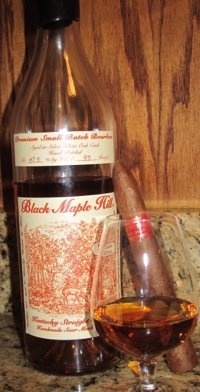Cigar Spirits: Black Maple Hill Small Batch Bourbon
27 Aug 2013
I’ve come to lump bourbons into two categories: those who make their bourbon and those who buy their bourbon. This isn’t a value judgement (I’ve had excellent and mediocre examples of each) just a matter of information. For some bourbons, the owner is a distiller; in other instances the owner is a “non-distiller producer” (NDP) who buys and perhaps ages and blends bourbon made elsewhere.
 By the way, the same is true of cigars. Some cigar makers have own their factory, while other brand owners contract someone else to make it for them. But for both bourbons and cigars there’s a wide range of those who fall in the latter category. Some companies are completely upfront about who makes their cigars (they may be more like co-producers), while others are completely secretive. Fortunately, for cigars, the top-secret undisclosed factory is the rarity.
By the way, the same is true of cigars. Some cigar makers have own their factory, while other brand owners contract someone else to make it for them. But for both bourbons and cigars there’s a wide range of those who fall in the latter category. Some companies are completely upfront about who makes their cigars (they may be more like co-producers), while others are completely secretive. Fortunately, for cigars, the top-secret undisclosed factory is the rarity.
For bourbons, those who don’t distill their own tend to be more tight-lipped about their sources. Black Maple Hill falls into that category. The California-based company has Kentucky Bourbon Distillers (itself an NDP) blend and bottle its bourbon. Sources aren’t disclosed, but Kentucky Bourbon Distillers says it buys bourbon from every major distiller except Maker’s Mark. Which ones end up in Black Maple Hill? The handful of people who know won’t tell.
Black Maple Hill occasionally releases very small runs of extra-old (and very pricey) bourbons and ryes, but these days, if you find it at all, it’s likely to be the Small Batch variety. It’s bottled at 95-proof (47.5 ABV) with no statement of age. Not long ago this could be found for $35-40, but now you might pay quite a bit more. My bottle cost $58 at my local Virginia state-run store and still it was sold out a week after I first spotted it on the shelf.
Black Maple Hill Small Batch is an orange amber color. The nose has corn along with coconut, toffee, and oak. On the palate corn continues to dominate with buttered kettle popcorn. There’s also fudge, malty sweetness, and caramel. In other words, tons of sweetness. The finish continues much the same way, with more corn sweetness and touches of oak.
It’s largely a one-dimensional bourbon (corn sweetness anyone?), but it’s a pleasant dimension, even if $60 seems like way too much for it. The sweetness makes it a versatile pairing with a fine cigar. A refined mild cigar (Macanudo or Davidoff) works just as well as a full-bodied maduro (RoMaCraft CroMagnon or La Riqueza).
Ultimately, for the price, Black Maple Hill Small Batch is outmatched by such staples as Blanton’s, Evan Williams Single Barrel Vintage, and fellow Kentucky Bourbon Distillers’ NDP Noah’s Mill. But I wouldn’t say don’t try it. I’d just say, don’t mythologize the fact that it’s so difficult to find. It may be relatively rare and quite tasty, but that combination doesn’t necessarily make it better than bourbons that are more easily procured.
photo credit: Stogie Guys

 Patrick Ashby
Co-Founder & Editor in Chief
Patrick Ashby
Co-Founder & Editor in Chief Patrick Semmens
Co-Founder & Publisher
Patrick Semmens
Co-Founder & Publisher George Edmonson
Tampa Bureau Chief
George Edmonson
Tampa Bureau Chief
I've enjoyed all of your articles on bourbon reviews, Patrick S. Thank you.
I like bourbon a lot but don't consider myself good at tasting and critiquing bourbon, per se. I know that sounds odd — if it tastes good just enjoy it, right? — but I'd like to know what to look for. What makes some of these rarer bourbons more complex, more balanced than some of the everyday stuff I tend to drink, like Maker's or Buffalo Trace?
I guess what I'm asking for is a future article that details how you evaluate a bourbon, what you look for, and what resources you use. I feel way more comfortable doing this with cigars.
Also, keep in mind I'm interested in this not because I want to be a snob, but to deepen my appreciation of bourbon.
Learning to taste bourbon is much the same as tasting cigars. The only way to get better at it is to pay close attention while you drink (or smoke). And then do that often with lots of different bourbons. Think about which flavors you find and then think about how the flavors interact with each other (complexity).
The best way to start would be drink a couple bourbons side-by-side. Maker's and BT would be a good place to start since Maker's is a wheated bourbon, and Buffalo Trace uses a more standard rye recipe (corn is of course the majority grain in all bourbons, but which secondary grain is used can really change the character). Then start trying bourbons of the same style side by side and pick out the differences.
If you're looking for reading, I highly recommend Chuck Cowdery's book Bourbon, Straight.